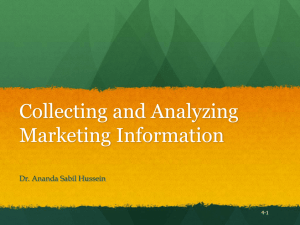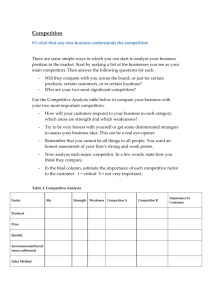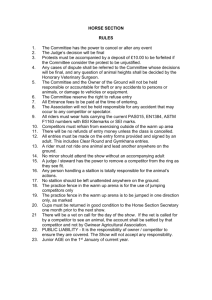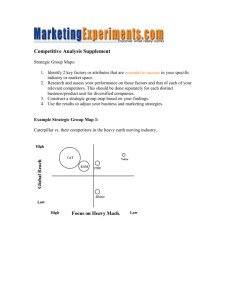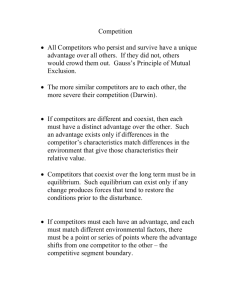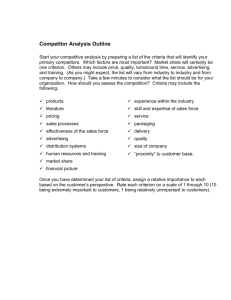Chapter 3
advertisement
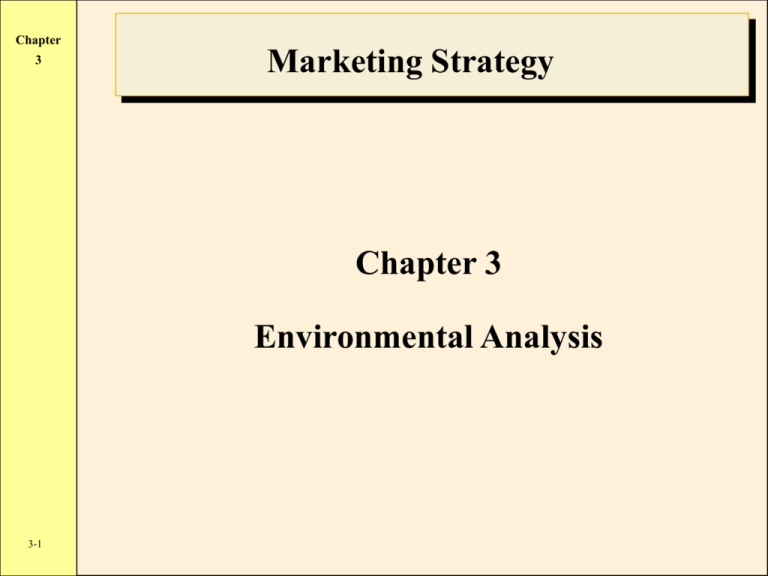
Chapter 3 Marketing Strategy Chapter 3 Environmental Analysis 3-1 Chapter 3 3-2 Environmental Analysis • Any effort at environmental analysis must be wellorganized, systematic, and supported by sufficient resources (e.g., people, financial, information). • Environmental analysis should be an ongoing effort. • A comprehensive environmental analysis can lead to better planning and decision making, but it should be combined with the manager's intuition and judgment to make the results of the analysis useful for planning purposes. • Environmental analysis empowers the marketing manager because it encourages both analysis and synthesis of information. Chapter 3 Data Versus Information • Managers are more likely to be overwhelmed with data rather than face a shortage. • Data does not become informative until it is transformed in a manner that makes it useful to decision makers. • Environmental analysis is valuable only to the extent that it improves the quality of the resulting plans and decisions. • Perpetually analyzing data without making any decisions is usually not worth the added expense. 3-3 Chapter 3 Three Key Environments • Analysis of the external environment (macroenvironmental) should include all the external factors— competitive, economic, political, legal/ regulatory, technological, and sociocultural—that can exert direct and indirect pressures on both domestic and international marketing activities. • The marketing manager should examine the customer environment (5 W’s) to assess the current and future situation with respect to customers in the firm's target markets. 3-4 • Finally, a critical evaluation of the firm's current and anticipated internal environment (microenvironmental) with respect to its objectives and performance, allocation of resources, structural characteristics, and political and power Chapter 3 Four Basic Types of Competition Brand Competitors: market products that are similar in features and benefits to the same customers at similar prices Product Competitors: compete in the same product class, but with products that are different in features, benefits, and price Generic Competitors: market very different products that solve the same problem or satisfy the same basic need Total Budget Competitors: compete for the limited financial resources of the same customers 3-5 Chapter 3 Stages of Competitive Analysis 1) Identify all current and potential brand, product, generic, and total budget competitors 2) Assess each key competitor in terms of relevant characteristics, such as size, profitability, growth, objectives, strategies, etc. 3) Assess each key competitor’s strengths and weaknesses, as well as the major competencies that each competitor possesses 4) Focus on each competitor’s marketing capabilities in terms of their products, pricing, distribution, and promotion 5) Estimate each competitor’s most likely strategies and responses under different environmental situations, as well as their reactions to the organization’s own marketing efforts 3-6 Chapter 3 Economic Conditions • A thorough examination of economic factors requires marketing managers to gauge and anticipate the general economic conditions of the nation, region, state, and local area in which they operate. • Economic factors to consider include inflation, employment and income levels, interest rates, taxes, trade restrictions and tariffs, current and future stages of the business cycle (prosperity, stagnation, recession, depression, and recovery), consumers' overall impressions of the economy and their ability and willingness to spend, and current and anticipated spending patterns of consumers in the firm's target market. 3-7 Chapter 3 Political Trends • Many marketers view political factors as being beyond their control and do little more than adjust the firm's strategies to accommodate changes in those factors. • Other firms take a more proactive stance by seeking to influence elected officials. 3-8 Chapter 3 Legal and Regulatory Factors • The marketing manager should carefully examine recent court decisions and recent rulings of federal, state, local and self-regulatory trade agencies to determine their effects on marketing activities. • Companies that engage in international marketing activities should also consider changes in the trade agreements between nations. 3-9 Chapter 3 Political & Legal Factors Legislation Legislation Impact Impact on on Marketing Marketing Sherman Sherman Act Act (1890) (1890) Prohibits Prohibits combination, combination,contracts, contracts,or or conspiracies conspiracies to totrade trade or or monopolization monopolization Clayton Clayton Act Act (1914) (1914) Prohibits, Prohibits,price price discrimination, discrimination,tying tyingclauses, clauses, and andexclusive exclusive dealer dealer arrangements arrangements FTC Created FTC Act Act Createdthe the FTC FTC and and gave gave itit investigatory investigatory power power to (1914) to deal deal with with antitrust antitrust powers powers (1914) RobinsonRobinson- Prohibits sellers from offering different deals to Prohibits sellers from offering different deals to Patman Act Patman Act different different customers customers for forlike like grade grade && quantity quantity (1936) (1936) 3-10 Chapter 3 Changes in Technology • Many changes in technology assume a frontstage presence in that they are most noticeable to customers. • Technological changes can also assume a backstage presence when their advantages are not necessarily apparent to consumers. 3-11 Chapter 3 Sociocultural Factors • Sociocultural factors are those social and cultural influences can cause changes in attitudes, beliefs, norms, customs, and lifestyles. – There are many changes taking place in the demographic makeup of the U.S. population. – Changes in cultural values can also create challenges and opportunities for marketers. 3-12 Chapter 3 The Customer Environment • Information should be collected that identifies – The firm's current and potential customers – The prevailing needs of current and potential customers – The basic features of the firm's and competitors' products that are perceived as meeting customers' needs – Anticipated changes in customers' needs • In assessing the firm's target markets, the marketing manager should attempt to understand all relevant buyer behavior and product usage statistics. 3-13 Chapter 3 5-W Model • Who Are Our Current and Potential Customers? • What Do Our Customers Do with Our Products? • Where Do Our Customers Purchase Our Products? • When Do Our Customers Purchase Our Products? • Why (and How) Do Our Customers Select Our Products? • Why Do Potential Customers Not Purchase Our Products? 3-14 Chapter 3 Who Are Our Current and Potential Customers? • The manager should consider – demographic characteristics (gender, age, income, occupation, education, ethnic background, family life cycle, etc.) – geographic characteristics (where customers live, density of the target market, etc.) – psychographic characteristics (attitudes, opinions, interests, motives, lifestyles, etc.) in defining the firm's target markets. • Depending on the type of products sold by the firm, purchase influencers, such as children or spouses, may be important as well. • For business-to-business marketers, the analysis should focus on the decision-making unit (DMU). 3-15 Chapter 3 What Do Our Customers Do with Our Products? • The "what" question entails an assessment of how customers consume and dispose of the firm's products. • Here the marketing manager might be interested in – identifying how often products are consumed (sometimes called the usage rate) – differences between heavy and light users of products – whether complementary products are used during consumption – what customers do with the firm's products after consumption 3-16 Chapter 3 Where Do Our Customers Purchase Our Products? • Until recently, most firms looked solely at traditional channels of distribution, such as brokers, wholesalers, and retailers. • Many other forms of distribution are available today, most notably nonstore retailing, which includes – – – – 3-17 vending machines door-to-door selling direct marketing through catalogs or infomercials electronic merchandising through computers and interactive television Chapter 3 When Do Our Customers Purchase Our Products? • The "when" question refers to any situational influences that may cause customer purchasing activity to vary over time, including the seasonality of the firm's products and the variability in purchasing activity caused by promotional events. • The "when" question also includes more subtle influences that can affect purchasing behavior, such as 3-18 – – – – – – physical and social surroundings time perceptions the purchase task time of day time available to search for alternatives what the purchase is intended to accomplish. Chapter 3 Why (and How) Do Our Customers Select Our Products? • The "why" question involves identifying the basic needsatisfying benefits provided by the firm's products. • The potential benefits provided by the features of competing products should also be analyzed. • It is also important to identify potential changes in customers' current needs and the needs that customers may have in the future. • The "how" part of this question refers to the means of payment that customers use when making a purchase. • How can we practice CRM 3-19 Chapter 3 Why Do Potential Customers Not Purchase the Organization’s Products? • Noncustomers have a basic need that the product does not fulfill • The product does not match noncustomers’ lifestyles or image • Competing products have better features or benefits • The product is too expensive for some customers • Noncustomers may have high switching costs • Noncustomers are simply unaware of the product’s existence • Noncustomers have misconceptions about the product • Poor distribution makes the product hard to find 3-20 Chapter 3 Internal Environment • First, the marketing manager must periodically assess the firm's current marketing goals, objectives, and performance. • Second, the marketing manager should review the current and anticipated levels of organizational resources that can be used for marketing purposes. 3-21 • Finally, the marketing manager should review current and anticipated structural issues that could affect marketing activities. Chapter 3 Collecting Environmental Data & Information • The marketing manager should invest time and money to perform research to uncover data that is pertinent to the development of the marketing plan. – This effort will always involve the collection of secondary data, which is compiled inside or outside the organization for some purpose other than the current analysis. – If the required data or information is not available, primary data may have to be collected through marketing research. – Accessing secondary data sources is usually preferable as a first option because they can be obtained more quickly and at less cost than collecting primary data. 3-22 Chapter 3 3-23 Sources of Environmental Data • Internal sources may also be a good source of data on customer needs, attitudes, and behavior. The organization's own records are the best source of data on current objectives, performance, and available resources. • The sheer volume of available information on the economy, our population, and business activities is the major strength of most government data sources. • The articles and research reports that are available in periodicals and books provide a gamut of information about many organizations, industries, and nations. • Commercial sources are almost always relevant to a specific issue because they deal with the actual behaviors of customers in the marketplace. • The best approach to secondary data collection is one that blends data and information from a variety of sources. • If needed secondary data is not available, out of date, inaccurate or unreliable, or irrelevant to the specific problem at hand, the manager may Chapter 3 Overcoming Problems in Data Collection • One of the most common problems is an incomplete or inaccurate assessment of the situation for which data is being gathered to address. • Another common difficulty is the expense of collecting environmental data. • A third issue is the time it takes to collect environmental data. 3-24 • A final challenge is finding a way to organize the vast amount of data and information that are collected during the environmental analysis.
